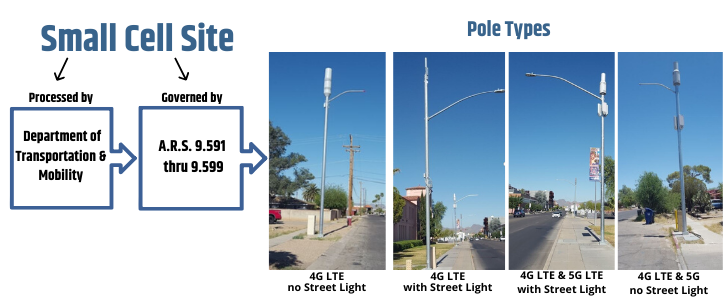Small Cell Poles - FAQs and Information
The City of Tucson is required by the laws of the State of Arizona to approve small cell pole installations in established rights-of-way. This requirement is detailed in the Arizona Revised Statutes: A.R.S. 9.591 though A.R.S. 9.599(PDF, 190KB) . This law dictates to all jurisdictions how small cell applications in the right-of-way are to be processed.
The Department of Transportation and Mobility (DTM) reviews all small cell applications for adherence to the requirements and limitations prescribed under the State law. State law requires that all small cell pole installations meet all adopted safety codes. In essence, when a small cell application is received, the City shall approve the installation of the small cell pole as prescribed by State Law.
View the street light map that includes planned and in place small cell poles.
The City of Tucson receives applications and plans for new cellular antennae sites. Cellular antennae are mounted in two basic ways:
Macro sites: Many large antennae mounted on tall towers, typically on private property, and on top of buildings
Small Cell sites: Antennae no larger than a total of 6 cubic feet in volume mounted on small cell poles


FAQs
- When a complaint comes in with health concerns regarding the small cell.
As the City of Tucson does not and cannot, under state and federal law, regulate small cell wireless technology based on health concerns, the following Federal and World Health Organization resources are provided to answer questions:
https://www.fcc.gov/engineering-technology/electromagnetic-compatibility-division/radio-frequency-safety/faq/rf-safety
https://www.fcc.gov/consumers/guides/wireless-devices-and-health-concerns
https://www.fda.gov/radiation-emitting-products/home-business-and-entertainment-products/cell-phones
- Will the small cell pole include a light?
When a small cell pole replaces an existing street light, a light will be replaced as part of the pole. If a brand new pole is added that did not previously exist, a light will not be included.
- Who installs the poles and what is their purpose?
The small cell poles currently being installed in the City are from AT&T and Verizon. At this point, AT&T is installing only 4G small cells. It should be anticipated that these will be upgraded to include 5G. Verizon installs both 4G and 5G small cells. The purpose of these small cell poles is reported to be for in home WiFi and streaming services and to provide a first responder private communication network called FirstNet.
- How does the state regulate small cell poles?
In 2018, the Arizona State Legislature adopted Chapter 5 - PUBLIC UTILITIES, Article 8 - Use of Public Highways by Wireless Providers (A.R.S. 9-591 thru 9-599). This law removes local jurisdiction discretionary approval of the placement location of small cell poles in City owned right-of-way, limits the fees that can be charged, and establishes a “shot clock” whereby if the City does not approve a location within a specified time frame, it shall be automatically approved. Small cell poles on private property and publicly owned property, exclusive of City owned right-of-way, are not governed under this State law.
- How are these different from cell towers?
Small cell poles differ from cell towers. Small cell poles are about the size of streetlights installed around Tucson. Cell Towers are extremely tall poles with many cellular antennae. Cell Towers still require Zoning Code approval by the Planning & Development Services Department.
- How are small cell poles regulated by the City?
Small cell poles are processed through the Department of Transportation and Mobility (DTM).
- How do I find out about existing and planned poles in my neighborhood?
On the small cell pole web page is a link where you can view the street light map that includes planned and in place small cell poles. There are two symbols used to identify small cell pole locations on the street light map; the symbols represent locations that indicate “Small-Cell Reserved” and “Small-Cell Pole”. The “Small-Cell Reserved” sites are added when a cellular company submits plans for a small cell and pays their initial fees. This status remains even after a permit has been issued. The actual construction start is often six months to a year or more after. This is largely due to a shortage of material and or contractors to perform the work. The “Small-Cell Pole” indicator is added once construction is scheduled to start.
Contact Transportation and Mobility
DTM is dedicated to continuously improving communications regarding the construction of small cell poles in the City. The department understands the constituent needs to be informed.
Additional Resources
League of Arizona - Small Cell
https://www.firstnet.com
https://www.crowncastle.com/communities/small-cell-information
https://www.wirelesshealthfacts.com/experts/